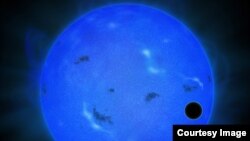Japanese astronomers say they have found a “super Earth” exoplanet with a water-rich atmosphere.
The astronomers observed the planet, Gilese 1214 b, using the Subaru Telescope' optics with a blue transmission filter.
“When combined with the findings of previous observations in other colors, this new observational result implies that GJ 1214 b is likely to have a water-rich atmosphere,” the National Astronomical Observatory of Japan wrote in a study report.
Gilese 1214 b was discovered in 2009 by the MEarth Project, which searches for the small reductions in the brightness of a star when an orbiting planet passes in front of it. The planet is located 40 light years from Earth in the constellation Ophiuchus, northwest of the center of the Milky Way.
Super Earth’s are a type of exoplanet with a mass and radius larger than Earth but less than the ice giants of our Solar System, Uranus and Neptune. But it remains to be seen whether the recently discovered super-Earths are more like large Earths or small
Neptunes because detailed observation is difficult.
The researchers say Gilese 1214 b might also have an atmosphere of hydrogen clouds so they plan to conduct follow-up observations in the near future to test their conclusion.
The astronomers observed the planet, Gilese 1214 b, using the Subaru Telescope' optics with a blue transmission filter.
“When combined with the findings of previous observations in other colors, this new observational result implies that GJ 1214 b is likely to have a water-rich atmosphere,” the National Astronomical Observatory of Japan wrote in a study report.
Gilese 1214 b was discovered in 2009 by the MEarth Project, which searches for the small reductions in the brightness of a star when an orbiting planet passes in front of it. The planet is located 40 light years from Earth in the constellation Ophiuchus, northwest of the center of the Milky Way.
Super Earth’s are a type of exoplanet with a mass and radius larger than Earth but less than the ice giants of our Solar System, Uranus and Neptune. But it remains to be seen whether the recently discovered super-Earths are more like large Earths or small
Neptunes because detailed observation is difficult.
The researchers say Gilese 1214 b might also have an atmosphere of hydrogen clouds so they plan to conduct follow-up observations in the near future to test their conclusion.








